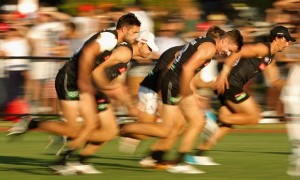Off Season Running – An Introductory Article
This will only be a fairly general first article on this topic, and we will expand upon this as well as give direction and advice with the running conditioning in the months ahead. But we will use this article to get a few key concepts out there straight off the bat.
The most common form of running that amateur and junior footy players out there do is the standard 5m or 10km runs to ‘get some km’s in the legs’ or ‘lay a foundation’ or to ‘be ready for the start of pre-season.’ So when someone says ‘I’m going for a run’, that is quite literally what they are doing. However this is a very inefficient use of time and effort, and your time and effort would be best spent changing this up slightly.
Think about a game of footy – a 2 hour period requiring all sorts of physicals tasks and challenges – tackling, running, kicking, pushing, pulling, jumping etc. Of course running will not be too much assistance in improving any of these tasks bar running. We already know this and that is where footy specific strength training comes into its own. But of course footy is a game based around locomotion, or running. So of course we go running to improve our ability to run in a game of footy. But lets take a closer look at the running in a game of footy.
When running in a game you will jog 30 meters, then accelerate and break into a sprint, decelerate and change directions 90 degrees and then reaccelerate again and sprint another 50 meters, before then stopping and walking for 20 seconds (potentially….depending.) Then in an instant you will have to break into a run again before stopping and resting again. This is just a small made up example of something that could really be any sort of combination of intermittent bursts of acceleration, deceleration, changes of direction, walking, jogging, running and sprinting.
It is important to note, that acceleration, deceleration and changes of direction make a particular exercise far more draining than if you were to just run the same distance in a straight line flat out. Done believe me – just go set up a shuttle run with 10, 20 and 30 meter markings, and run this shuttle run flat out. Then run 120m sprint – and you decide for yourself which one has left you feling more drained. Then try doing 4 of the shuttles (with say a 90 second rest in between each) and 4 of the 120m sprints, with a 90 second rest after each – and you will really see the difference – and this is relevant, because footy is about repeat efforts, not just one effort. And then to top this off, in a game you have absolutely no idea the order that these changes will come in, which makes them even more physically as well as mentally taxing. When you know what’s coming, it is both physically and mentally less challenging, as you can plan and prepare and almost ‘ration’ your effort levels if you like.
So now lets look at that 5km run. There is no acceleration and deceleration or changes of direction. There is no sprint (apart from maybe your last 100m, by which time it wont be a true sprint anyway.) There is no lateral movement. There is no ultra-intense work, nor recovery periods to allow more intense work. There is no heart rate variability (intermittent increase and decrease.) There is no real consideration for fast twitch muscle fiber training, but rather largely slow twitch. In short, whilst you are getting your heart rate up, and will indeed be working hard (you are running 5km, this certainly isn’t a walk in the park, don’t get me wrong), you aren’t performing a form of conditioning that will have anywhere near as much carryover to the conditions and tasks you will require when running in a game of footy.


As a footy player, do yourself a favour and leave the road running to this guy
So as you begin to get into some base running in this October period, it is important to keep this in mind, and look to do slightly more shorter and relevant forms of running, yet executed at a higher intensity. Having said that, my primary piece of advice in this article too is that it is October – so keep things in context here – there is absolutely no point going hard and training every day like a ‘bat out of hell’ and running yourself into the ground and then peaking in December. This is about putting in some yards to gradually build an appropriate work capacity that will then be further developed gradually throughout the pre season. You are aiming to gradually introduce your systems (cardiovascular, respiratory, muscular-skeletal and hormonal) to the demands they will be faced with in games, which will not only improve performance but also reduce injuries (particularly overuse injuries from too much running and on hard surfaces) and keep you out training and playing longer.
We will expand greatly on this topic, as well as the terms we have touched on here (fast twitch, slow twitch, aerobic, anaerobic, etc) and continue to give examples of how exactly to go about this in the next few months. So stay tuned. In the mean time, here are a couple examples of the types of ‘base running’ to slowly introduce back into running, instead of going for a 5km or 10km run.

After a proper warm up of course, including running at gradually increased speed as well as active stretches
Set up some form of markers, roughly 10, 20, 30, and 40 meters apart. Perform 4 shuttle runs at about 60-70% speed (don’t go flat out) to just get your muscles and joints used to the accelerating, decelerating and changing directions that will become so prevalent in the footy ahead. Give yourself a 90 second rest between shuttle runs. Also ensure you are focusing on the quality of your deceleration and changes of direction (foot placement, stability, etc), rather than simply just doing the shuttles.
These shuttle runs are a good thing to throw in at the start of a running session (after a proper warm up of course.) And then follow these up with some extra running. Remember, nothing too crazy or lengthy yet – its only October.
Do an 8-12 minute run, where every minute, the first 40 seconds of that minute is slow (like 30-40% effort/speed) followed by 20 seconds of fast (80-85%, NOT FLAT OUT AT THIS STAGE.) Alternatively you could break this up into 2 separate 5-8 minute efforts of this same exercise, with a 3-5 minute rest.
Another option is to think in terms of distance, rather than time. At you park/oval, hopefully you have a circumference around the oval that is roughly 400m (300-500m is fine.) Walk ¼ of the oval, jog ¼ of the oval, and then run (at that 80-85% effort) for the remaining ½ a lap. Repeat and perform 8-10 laps of this.
Of course these are generalities – you may feel fit enough to add on extra repetitions and extra laps, but follow the concept and general outline, and remember, don’t do too much yet. You may be a looking to be super fit for the start of pre-season where you are hoping to impress at training with aims of making a TAC cup squat or junior SANFL squad (if you are a junior) to make you’re A-grade side at your club, however sides wont be picked based on training in November. You want your body peaking in February/March, and you wont do this if you are either injured or burnt out.
Stay tuned for more in the coming weeks and months.
Strength coach

